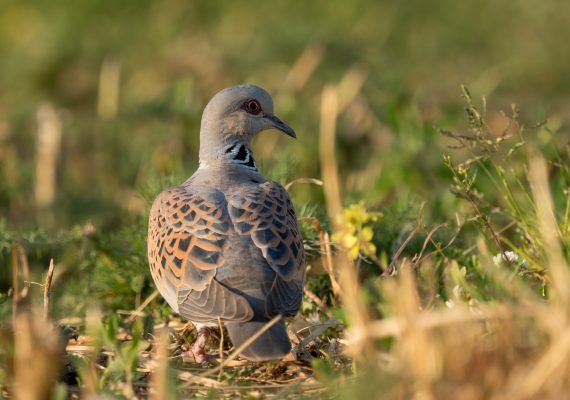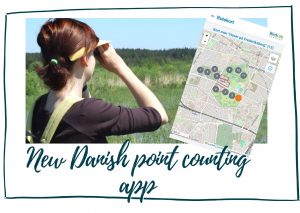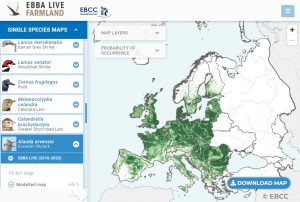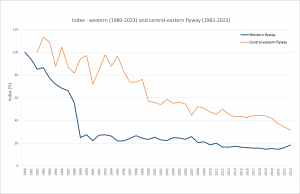
Thanks to the enormous effort of the national coordinators to deliver data till 2023, we have been able to produce the most up-to-date outputs this spring and showed that the Turtle Dove index in the western flyway with working hunting moratoria and restrictions has been improving for the last three years. Photo by Lubo Ondraško
Report on the PECBMS, September 2024
September 19, 2024
The project, funded by the EC, focuses on developing bird indicators for the EU, improving data collection and analysis, and contributing to bird conservation efforts, including the protection of the Turtle Dove and the development of novel indices like the Urban or Mountain Bird Index.

Thanks to the enormous effort of the national coordinators to deliver data till 2023, we have been able to produce the most up-to-date outputs this spring and showed that the Turtle Dove index in the western flyway with working hunting moratoria and restrictions has been improving for the last three years. Photo by Lubo Ondraško
Summary
Data until 2023 were collected from 29 countries and uploaded to the PECBMS online tool. Technical improvements were made in early 2024 to streamline data validation. Site-level data from 11 countries were updated, and the Urban Bird Index is being developed under the EU Biodiversity Strategy for 2030. The Mountain Bird Indicator and the EBBA Live Farmland project are also underway. PECBMS has contributed to the Turtle Dove protection project, indicating population stabilisation in the Western flyway. The International Census Plots pilot schemes expanded to seven countries, aiming to fill breeding bird survey gaps. Research outputs include papers on farmland bird population decline and urban bird trends. PECBMS actively communicates progress through newsletters and social media, maintaining engagement with national coordinators and stakeholders.
Project funding
The project is funded by the EC contract called “Service Contract for providing technical and scientific support in relation to the delivery and development of wild bird indicators for the EU (2023–2026).” Other sources, including data handling fees, contribute to achieving a long-term goal: sustainable funding of PEBCMS.
Gathering data for the production of European species indices, indicators and their trends
Data until 2023 were gathered from 29 countries; 1 country delivered data until 2022. National data from each country were uploaded into the PECBMS online tool. Each species from every country is checked, and its data quality is assessed. The European species index and indicator calculations will start soon; we plan to publish them in late autumn 2024.
Technical improvements
Most technical improvements were made at the start of 2024 to prepare for the data request and new data delivery. Therefore, the latest tool modifications were made based on the coordinators’ comments. For example, the site-level data tool now allows users to download all the data with warnings that need to be validated to facilitate the data checks by the national coordinators.
RTRIM-shell code was changed so that the usual user is not affected to run smoothly.
Site-level data
Site-level data from 11 monitoring schemes has been updated: Austria, Spain (Catalonia), Cyprus, Denmark, Finland, France, Ireland, Netherlands, Slovenia, Switzerland and the United Kingdom.
Presentation of results and promotion
We informed the national coordinators and the wider audience, comprising 762 contacts, on the progress of the PECBMS via reports in the quarterly electronic EBCC Newsletter (Spring and Summer issues 2024). All issues are available online at the pecbms.info website (and www.ebcc.info).

Fig. 1 Title pages of the EBCC newsletters
The PECBMS website, www.pecbms.info, has been updated regularly. In the given period, we published seven news articles and updated the list of publications, PECBMS methods, and information on the European bird monitoring schemes.
To address the wider public, we maintained Facebook and Twitter profiles and updated the posts regularly—6 news items directly regarding the PECBMS from 16 March 2022 to 6 September 2024.

Fig. 2 Danish colleagues have developed a brand new point-counting app! Promoted via FB and Twitter on 6 September
A Novel Urban Bird Indicator development
We started developing a novel Urban Bird Index, enabling the monitoring of urban greening under the EU Biodiversity Strategy for 2030. This is one of the tasks under the current EC contract. So far, the Urban Bird Index has only been published in Spain. We started exploring the approaches to UBI methods within a working group comprising the PECBMS core team and colleagues representing CREAF and RSPB. By the end of 2025, we plan to finish the index development and publish the first UBI by December 2026.
Progress of the Mountain Bird Indicator development
In May 2024, we shared a summary of our aims to develop and regularly update the European mountain bird indicator with national coordinators. We have obtained updated site-level data in the last months and started the spatial analysis to select the new mountain sites. We plan to publish the novel indicator in 2025.
EBBA Live Farmland: updating distributions of farmland birds in Europe
EBCC has started a pilot project on farmland birds called EBBA Live Farmland. The project’s first phase has ended, and the results are available on a specific section of the EBBA2 webpage. The outputs are maps showing the occurrence of 50 farmland bird species based on data from general bird monitoring projects, most of which are integrated into the PECBMS. New 10-km modelled distribution maps for the post-EBBA2 period 2018–2022 are now available online through the EBBA2 webpage. The work for this phase was carried out in the context of the EuropaBON project.

Fig. 3 Screenshot from the EBBA Live Farmland section of the EBBA2 website
PECBMS’s contribution to the Turtle Dove protection
PECBMS became part of a group working on the European turtle dove population improvement project due to the hunting restrictions. We calculated indices for Western and Central-Eastern European flyways. The good news is that it seems that the population has stabilised in the Western flyway, where hunting was almost completely paused. On the contrary, the situation in the Central-Eastern flyway, where hunting has only been slightly restricted, is that the population is still dropping. A couple of publications have already emerged from this project. PECBMS will continue to calculate flyway-specific Turtle Dove indices next year.

Fig 4. Graph western flyway till 2023. It seems that the hunting restrictions have already positively affected the Turtle Doves. The index has been slightly increasing in the last three years.
The International Census Plots (ICP)
The International Census Plots (ICP) are believed to be a step towards filling gaps in breeding bird surveys in parts of Europe, which are not sufficiently covered by monitoring schemes. The pilot schemes in Serbia (since 2021) and Moldova (since 2022) helped to test the methodology. Then, the ICP started in five more countries in the Western Balkans. Thus, in 2024, we ran the ICP in 7 countries. The data have been delivered to the PECBMS coordination team and have been carefully checked. The data checks’ outputs, including the national coordinators’ feedback, will be used to improve the scheme in forthcoming years.
Research
The PECBMS data has been used in several studies. Site-level data on 50 farmland birds has been involved in the EBBA2 Live project, which attempts to update EBBA2 maps of farmland birds (period 2013–2017) with maps based on PECBMS data (2018–2022).
List of papers published:
Jiří Reif, Anna Gamero, Adriana Hološková, Ainars Aunins, Tomasz Chodkiewicz, Iordan Hristov, Petras Kurlavičius, Meelis Leivits, Tibor Szép, Petr Voříšek: Accelerated farmland bird population declines in European countries after their recent EU accession. Science of The Total Environment. Volume 946, 2024, 174281, ISSN 0048-9697. https://doi.org/10.1016/j.scitotenv.2024.174281
Carboneras, C., Cruz-Flores, M., Colomer, M.À., Šilarová, E., Škorpilová, J. & Arroyo, B. (2024). Turtle Dove Adaptive Harvest Management mechanism – March 2024 Technical update (western flyway). Presented at the 5th meeting of the Task Force on the Recovery of Birds (TFRB). PDF
Šilarová E. and Klvaňová A. 2024: Turtle Dove Conservation. The Breeding Bird Survey 2023, p. 9, BTO Research Report 765. British Trust for Ornithology, Thetford. PDF
Jan Grünwald, Ainārs Auniņš, Mattia Brambilla, Virginia Escandell, Daniel Palm Eskildsen, Tomasz Chodkiewicz, Benoît Fontaine, Frédéric Jiguet, John Atle Kålås, Johannes Kamp, Alena Klvaňová, Lechosław Kuczyński, Aleksi Lehikoinen, Åke Lindström, Renno Nellis, Ingar Jostein Øien, Eva Šilarová, Nicolas Strebel, Thomas Vikstrøm, Petr Voříšek, Jiří Reif: Ecological traits predict population trends of urban birds in Europe. Ecological Indicators. Volume 160, 2024, 111926, ISSN 1470-160X. https://doi.org/10.1016/j.ecolind.2024.111926
Maintain and update the network of cooperating organisations and individuals.
We provided advice and consultations to the national coordinators upon request and assistance to various countries: Andorra, Austria, Cyprus, Czechia, Lithuania, and Poland.
Active communication with the scheme stakeholders
- EBCC office meetings (monthly)
- PECBMS department meetings (monthly)
- Technical meetings within the team (twice a year), incl. experts
- regular meetings and e-mail communication with DG ENV
- Commenting on the EUROSTAT website, presenting the Common Bird Index
- Commenting on the EEA factsheet on the 2024 edition of the 8th EAP monitoring report & update of SEBI 027 indicator with data up to 2022
- Participated in the Horizon 2020 project called Biomonitoring for CAP Annual Meeting in Lisabon (12–15 March 2024).
Reporting to the EBCC Board
We regularly attended EBCC Board meetings in person from 19–21 March in the UK and online on 20 June, where we presented the PECBMS progress and main outputs for the given periods.

Fig. 5 Birdwatching eiders, puffins, widgeons, cormorants, curlews, purple sandpipers, great black-backed gulls, turnstones, shelducks, white-fronted geese, etc. during the EBCC Board meeting in Northumbria, UK